

The Future Is Now: 15 Innovations to Watch For - Commentary. By Steven Mintz Profound transformations have reshaped the higher-education landscape in roughly 50-year intervals.
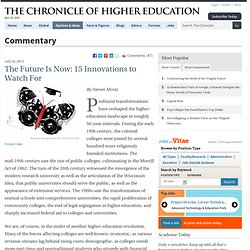
During the early 19th century, the colonial colleges were joined by several hundred more religiously founded institutions. The mid-19th century saw the rise of public colleges, culminating in the Morrill Act of 1862. The turn of the 20th century witnessed the emergence of the modern research university as well as the articulation of the Wisconsin Idea, that public universities should serve the public, as well as the appearance of extension services. The 1960s saw the transformation of normal schools into comprehensive universities, the rapid proliferation of community colleges, the end of legal segregation in higher education, and sharply increased federal aid to colleges and universities. We are, of course, in the midst of another higher-education revolution. Centre for Teaching Excellence. What are microteaching sessions?
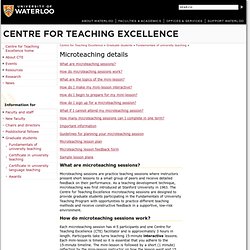
How do microteaching sessions work? What are the topics of the mini-lesson? Center for Teaching: Achieving Teaching and Learning Excellence Through Faculty Learning Communities. Essays on Teaching Excellence Toward the Best in the Academy Vol. 14, No. 4, 2002-2003 Milton D.
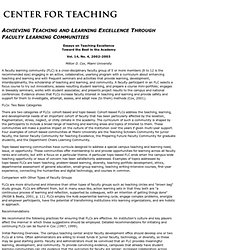
Cox, Miami University. Center for Teaching: Achieving Teaching and Learning Excellence Through Faculty Learning Communities. Implement & Improve - Simmons Resources. Open Learning Initiative. Why I Gave Up Flipped Instruction. A little over a year ago I wrote a post about the flipped classroom, why I loved it, and how I used it.
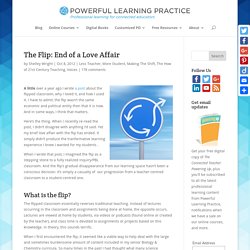
I have to admit, the flip wasn’t the same economic and political entity then that it is now. And in some ways, I think that matters. Here’s the thing. When I recently re-read the post, I didn’t disagree with anything I’d said. Yet my brief love affair with the flip has ended. When I wrote that post, I imagined the flip as a stepping stone to a fully realized inquiry/PBL classroom. Lessons Worth Sharing. Google. Epigeum - Online training for higher education, healthcare and research institutes. Finding Non-Copyrighted Images for Presentations. By Derek Bruff, CFT Director [Note: I prepared this guide for the faculty participating in Vanderbilt's Coursera pilot, but I believe it will be useful to any instructor interested in using more images in presentations and lectures.
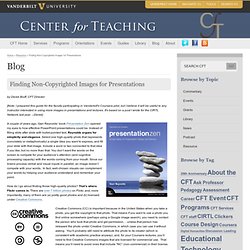
It's based on a post I wrote for the CIRTL Network last year. --Derek] A couple of years ago, Garr Reynolds’ book Presentation Zen opened my eyes to how effective PowerPoint presentations could be. Instead of filling slide after slide with bullet-pointed text, Reynolds argues for simplicity and elegance. How do I go about finding those high-quality photos? Creative Commons (CC) is important because in the United States when you take a photo, you get the copyright to that photo. (That’s the basics of Creative Commons. When I want to find an image for a presentation (whether I’m using Prezi or PowerPoint), I head to Compfight, which is a third-party site that makes it quick and easy to search Flickr. Tags: Coursera, Lecturing, Visual Thinking. Becoming a College Teacher. Theories of human learning indicate that feedback is critical in the learning process.

For example, Robert Gagné’s theory about the conditions of learning posits that feedback is one of the nine critical phases in the learning process.9 Similarly, B.F. Skinner indicates that feedback is most helpful in learning when it is received immediately following a response. When a student receives immediate feedback, it allows him or her to correct any misconceptions he/she holds. This is important because the longer a misconception persists, the more challenging it is to change. In the classroom, it is challenging to provide immediate feedback to students. Critical Thinking in the Curriculum. A guest post by Donald Lazere.

“Baby Logic”: The Disdained Discipline in American Colleges Several recent studies identifying the weak spots in both American K-12 and college education, like Richard Arum and Josipa Roksa’s Academically Adrift, the Common Core State Standards Initiative of the National Governors’ Association, and Martha Nussbaum’s Not for Profit, lament the lack of learning in critical thinking and argumentation. Yet none of these studies that I have seen discuss at any length the disciplinary and curricular context in which these subjects are, or should be, taught; nor are they very specific about delineating their content.
A movement to implement critical thinking courses peaked around l980, when Chancellor Glenn Dumke announced the requirement of formal instruction in critical thinking throughout the nineteen California State University campuses, serving some 300,000 students. Eric Mazur on new interactive teaching techniques. In 1990, after seven years of teaching at Harvard, Eric Mazur, now Balkanski professor of physics and applied physics, was delivering clear, polished lectures and demonstrations and getting high student evaluations for his introductory Physics 11 course, populated mainly by premed and engineering students who were successfully solving complicated problems.

Then he discovered that his success as a teacher “was a complete illusion, a house of cards.” The epiphany came via an article in the American Journal of Physics by Arizona State professor David Hestenes. Fire (1996 film) The film is loosely based on Ismat Chugtai's 1941 story, Lihaf (The Quilt).[1] It was one of the first mainstream films in India to explicitly show homosexual relations.
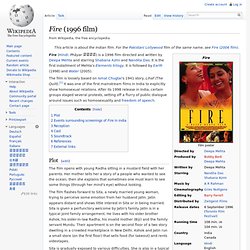
After its 1998 release in India, certain groups staged several protests, setting off a flurry of public dialogue around issues such as homosexuality and freedom of speech. The film opens with young Radha sitting in a mustard field with her parents. Her mother tells her a story of a people who wanted to see the ocean; then she explains that sometimes one must learn to see some things (through her mind's eye) without looking. The film flashes forward to Sita, a newly married young woman, trying to perceive some emotion from her husband Jatin. Engaging the Curriculum in Higher Education - Ronald Barnett, Kelly Coate. Other Faculty Development Centers - The Teaching and Learning Center. List of faculty development centers. Focus - Centre for Learning and Teaching. Support student success Support Dal Dalhousie University - Inspiring Minds.
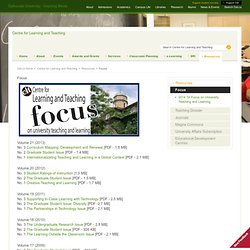
The Centre for Teaching & Learning. Blended Learning Toolkit. Newsletter. Assessing Faculty Readiness to Teach Online - The Learning House. Teaching and Learning Resources Portal. Welcome to the Teaching and Learning Resources Portal. Here you will find resources to support your development both as a teacher and a learner. You will find pages containing an overview and bibliography on a diverse range of teaching and learning topics, strategies, issues and tools. These resources are intended for anyone interested in teaching and learning, including ISW participants, facilitators, faculty, staff and students. Everyone is encouraged to add or edit pages. Integrating Instructional Technology into Your Courses. Introduction Teaching and learning can be enhanced through the effective use of technology.
This section opens with links to websites that provide teaching strategies, examples, and information for using technology in teaching all disciplines, followed by a link for courses in the sciences. Next, mega-sites on technology in teaching provide articles, research reports, teaching strategies, and examples of technology integrated into courses. Articles. April 23 - Class Discussion Challenge: Getting Students to Listen and Respond to Each Other’s Comments By: Maryellen Weimer, PhD in Teaching Professor Blog Issue 1: The classroom discussion is going pretty well. Students are offering some good comments and more than one hand is in the air. Then a student makes a really excellent observation that opens up a whole avenue of relevant possibilities.
Faculty. Graduate School: Certificate In College Teaching. Certificate in College Teaching The Certificate in College Teaching (CCT) program is for enrolled PhD students in any department or program of study at Duke. This program makes use of departmental training and resources as well as Graduate School programming. The Certificate in College Teaching will appear on the transcript of Duke PhD students who complete its requirements as an officially endorsed Duke University Graduate School certificate; it is being offered in order to recognize and validate professional development activities undertaken by PhD students and add competitiveness and value to PhDs awarded to Duke graduate students.
The goals of the CCT program are to facilitate and recognize graduate students’ completion of: Requirements. Centre for Teaching Excellence.
NCSU Office of Faculty Development. NC State provides resources and professional development opportunities to enable faculty to enhance the use of technology in teaching to enable effective learning for students. Archived workshops on teaching with technology can be found here. Basic Information About Teaching with Technology at NC State Distance Learning and Technology Applications (DELTA) assistance with Producing Courses Learning Management Systems (LMS) at NC State University Migration to Moodle – Announcement.
LITREDirectory. Faculty Development. Teaching and Learning Centre Support.